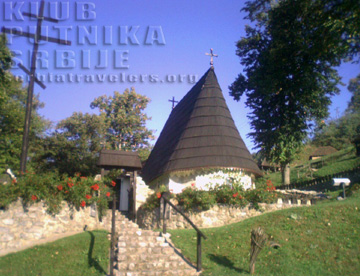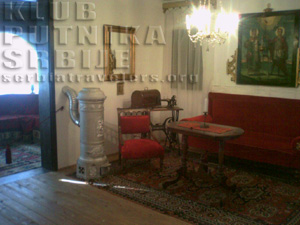Krupanj & Dobri Potok
Dobri Potok is a valley in Radjevina region, interesting for its old wooden church dedicated to the Assumption of the Holy Mother of God.  Near the church there's an old graveyard with some unusual tombstones, and a small ethno-museum complex, with a few wooden houses built in traditional style.
Near the church there's an old graveyard with some unusual tombstones, and a small ethno-museum complex, with a few wooden houses built in traditional style.
The complex houses an ethnographic museum and a natural history museum, with rich collection of items related to the history of the region.
Dobri Potok is located just 1 km north of the town of Krupanj, at the foot of Jagodnja, Boranja and Sokolska mountains, some 280 meters above sea level in the very heart of Radjevina area.
The church and the museum complex are located between the village of Lipenovici and the town of Krupanj.
History of Krupanj & Dobri Potok
Krupanj was an important town in the medieval Serbian Kingdom, being at the centre of important historical happenings. Most of the tombstons scattered all over the Krupanj area date from this period. People from the state of Dubrovnik, attracted by the rich ore deposits, settled in area which became an important trade center. They even built a Catholic church there, which sadly doesn't exist anymore.
When the Turks finally invaded Serbia in 1459, Krupanj became a part of sandzak (tur. district) of Zvornik, in Bosnian pashaluk (tur. region). In Turkish registries from 16th and 17th century Krupanj is mentioned as a miners' settlement with a market, but from the beginning of the 17th century it becomes kadiluk (center of jurisdiction) and kasaba (town).
According to a local legend, the church in Dobri Potok (meaning "Good Stream") was supposed to be built in the nearby Lazarica, but whatever was built during the day collapsed over the night. They decided to look for better foundations, which they managed to find just before the dark, at the bank of a stream. The works on the church in Lazarica were terminated immediately and the new one was built “in a good place where God wanted it to be”.
The church was partially burned by the Turks in 1711, but was renovated soon after.
 After the Pozarevac Peace Declaration was signed in 1718, the northwest part of Serbia, including the town of Krupanj, became part of the Austrian Empire. In 1791 Austria and Turkey signed a treaty returning Krupanj to the Ottoman Empire. In 1804 harambasa (the leader of the uprising) Djordje Obradovic Curcija from Krupanj started the First Serbian Uprising in this region.
After the Pozarevac Peace Declaration was signed in 1718, the northwest part of Serbia, including the town of Krupanj, became part of the Austrian Empire. In 1791 Austria and Turkey signed a treaty returning Krupanj to the Ottoman Empire. In 1804 harambasa (the leader of the uprising) Djordje Obradovic Curcija from Krupanj started the First Serbian Uprising in this region.
Until 1834 Krupanj belonged to the sandzak of Zvornik in Bosnian pashaluk. Due to the efforts of duke Milos Obrenovic, Krupanj and Radjevina were joined with Serbia in 1834. Captain Petar Radojlovic forced the Turks out of the fotress town of Soko-Grad, destroying this huge fortress in 1862.
The WWI famous battles on the Drina River and Mackov Kamen took place here. During the WWII Krupanj was bombed and burned to the ground as one of the most important centers of the Republic of Uzice, but was rebuilt after the war.
{tab=getting there}Getting to Krupanj & Dobri Potok
The valley of Dobri Potok, with its church and ethnographical museum, is located 1 km north of Krupanj, on the outskirts of the Lipenovici village, at the foot of Jagodnja, Boranja and Sokolska mountains.
A number of daily buses connect Krupanj with the nearby towns of Valjevo and Sabac. Both Valjevo and Sabac can be easily reached by bus from Belgrade.
From Krupanj to the Dobri Potok valley & church it is a 15 minutes walk.
What to see in Krupanj & Dobri Potok?
The Assumption church of the Holy Mother of God is one of the oldest churches in the area. Although it was damaged several times during the past centuries, it has kept its original appearance.
At the entrance of the church yard there are two wooden gates, the small and the big one, standing on pillars and covered with wooden shingles. Under the smaller gate there's a memorial plaque dedicated to Milos Obrenovic, as well as a plaque telling the history of the church.
The church itself, including the roof, is made of oak wood. The parvis is decorated with interesting engravings.  In the church there's a completely preserved iconostasis from 1826. The dormitory is in front of the church, and the bell tower, built in the 19th century, is just behind it. The dining room and museum complex are parts of the dormitory.
In the church there's a completely preserved iconostasis from 1826. The dormitory is in front of the church, and the bell tower, built in the 19th century, is just behind it. The dining room and museum complex are parts of the dormitory.
Ethnographic museum houses all kinds of old household utensils from this region. Besides the natural history museum, there is also the Museum of the Interior, where you can see what a typical traditional house in Radjevina looked like, including the furniture, carpets, paintings etc.
At the entrance of the church there are two underground chapels, built in the deserted mines. The first one is the Chapel of St. Prokopije, the protector of the miners, and the other one is the Chapel of St. Petka. Next to the chapels there is an old graveyard with many interesting tombstones.
Nearby you'll find a drinking-water fountain “Braca Jugovic”, famous since the 19th century, and plenty of commemoration plaques dedicated to, for example, harambasa Djordje Obradovic Curcija, the leader of Radjevina people in the 1804 uprising against the Turks; Duke Krsta Ignjatovic, who defended Krupanj from the Turks from 1804 to 1812; Captain Petar Radojlovic who ousted Turks and demolished Soko-grad in 1862 etc.
{/tabs}

